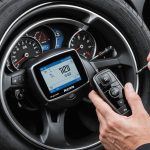Overview of Hybrid Vehicle Electrical Systems
Understanding hybrid vehicle electrical systems is crucial for ensuring both efficient operation and vehicle safety. These systems are more complex than those in traditional vehicles, incorporating components like electric motors, power electronics, and high-voltage batteries. These elements play key roles in the hybrid vehicle’s performance by providing additional power or allowing a vehicle to operate solely on electric energy, thereby improving fuel economy.
Proper comprehension of the electrical systems is particularly important because it significantly impacts vehicle safety. An inadequate grasp can lead to mishandling, which might cause electric shocks or damage to the vehicle. Recognising the configuration and function of each component allows for safer operation and maintenance.
Topic to read : Ultimate guide: must-check components of your vehicle”s emergency braking system before you hit the road
There are several common electrical hazards associated with hybrids. For instance, the high-voltage components can pose risks of electric shock or fire if not handled correctly. Hybrid vehicles often include warning labels highlighting these hazards, reminding users of the potential dangers. Regular training and awareness of these systems are vital, as it helps in identifying risks and adopting appropriate safety measures. By gaining a thorough understanding, owners and technicians can significantly lower the risks associated with electrical mishaps in hybrid vehicles.
Safety Protocols for Inspecting Hybrid Electrical Systems
When inspecting hybrid electrical systems, adhering to safety protocols is vital for both inspectors and vehicle integrity. Essential safety measures should be established before beginning any inspection process.
Also to discover : Mastering diesel fuel injection: key strategies for inspection and maintenance
First and foremost, inspectors must ensure the use of appropriate personal protective equipment (PPE). This includes wearing insulated gloves and voltage-rated footwear to prevent electrical shock. It is also prudent to don face shields and protective overalls to guard against arc flash, which is a potential hazard within high-voltage environments.
Creating a secure and controlled inspection environment is another critical step. Inspectors need to verify that all electrical safety guidelines are followed, such as clearly marking off the area to prevent unauthorized access, thereby minimizing risk. Additionally, vehicles should be in a state of rest; this means the ignition must be off, and power sources disconnected, negating unexpected electric flows.
Finally, instituting best practices, like regular equipment checks and ensuring tools are in optimal condition, enhances safety. Training sessions for keeping the team updated on new inspection practices and technological advancements further solidify these safety approaches, thereby fortifying protection during inspections. Investing in education and proper safety protocol ensures a reliable and secure inspection process.
Tools and Equipment for Electrical System Inspections
When inspecting hybrid vehicle electrical systems, having the correct inspection tools and diagnostic equipment is indispensable. These resources ensure precise evaluations and promote safety.
Necessary Tools
A comprehensive toolkit should include:
- Insulated tools: Essential to prevent accidental electric shocks.
- Multimeters: These devices measure voltage, current, and resistance, offering invaluable data about a vehicle’s electrical status.
- Insulation testers: Necessary for detecting degradation in high voltage components’ insulation.
Diagnostic Equipment
Advanced diagnostic equipment provides robust data aiding in accurate assessments. Equipment like scanners that interface with the vehicle’s onboard diagnostics systems are pivotal. They read error codes and offer insights into internal anomalies. Oscilloscopes, while more advanced, visualize voltage changes over time, providing a dynamic view of the electrical activity.
Importance of Safety Gear
Beyond tools, proper safety gear like PPE remains crucial. High-voltage gloves, face shields, and voltage-rated boots should always be worn to minimise risk. This gear not only protects inspectors from electrical hazards but also ensures confidence through secure handling.
Utilising the right tools, equipment, and safety gear effectively supports the delivery of precise and safe hybrid electrical system inspections.
Step-by-Step Inspection Process
When conducting a comprehensive inspection of hybrid electrical systems, following a detailed process ensures safety and accuracy. Below is a systematic guide for inspectors who wish to cover all crucial aspects effectively.
1. Pre-Inspection Preparation
Before you start, ensure all inspection tools and safety gear are readily available. This includes insulated tools and diagnostic equipment critical for assessing the electrical components.
2. Initial System Assessment
Begin by analysing the vehicle’s electrical systems with diagnostic equipment to identify error codes or anomalies. Tools like scanners can interface with the onboard diagnostics to highlight immediate issues.
3. Visual and Physical Inspection
Inspect all visible and accessible components for signs of wear, damage, or corrosion. Pay attention to connections and wiring, as faults here often lead to electrical issues.
4. Electrical Testing
Utilise multimeters and oscilloscopes to test voltage and current, ensuring components are functioning within expected parameters. Check for insulation integrity to prevent future hazards.
5. Closing Checks and Feedback
After completing tests, review all findings to ensure nothing has been missed. Document the information and provide feedback or repairs needed for safe vehicle operation.
This structured inspection process not only enhances vehicle safety but also reinforces best practices for both seasoned inspectors and DIY enthusiasts.
Identifying and Mitigating Potential Hazards
Hybrid vehicle electrical systems come with unique challenges, particularly their associated hazard identification needs. These high-voltage systems present electrical hazards such as potential electric shock or fire risks, often stemming from inadequate handling or insulation failures.
Risk mitigation is paramount during inspections. Inspectors should first identify possible weak points within the electrical systems, including any exposed wiring or degraded insulation. Usage of diagnostic equipment can help detect anomalies that might not be visible upon a basic inspection. For example, oscilloscopes allow inspectors to closely monitor voltage changes, signalling any irregular behaviour in the system.
Ongoing training and education are crucial in effectively recognizing and managing these hazards. Regularly updated training sessions on the latest safety protocols and technological advancements ensure inspectors remain competent in their field. This continuous education helps them stay aware of potential dangers and develop skills to address them promptly.
Mitigation strategies also involve ensuring all safety gear and inspection tools are in top condition. This includes routine checks and replacements when necessary. By integrating comprehensive hazard identification, thorough risk assessment, and strategic mitigation approaches, inspectors can significantly enhance vehicle safety and reduce potential threats associated with hybrid vehicle electrical systems.
Regulatory Standards and Compliance
Understanding regulatory standards and compliance guidelines is essential for maintaining safety and avoiding potential liabilities during hybrid vehicle inspections. These standards ensure that inspection practices align with the latest safety regulations and innovations within the automotive industry.
At the forefront of these regulations are specific compliance requirements that safeguard inspectors and vehicle owners. Compliance involves adhering to specified procedures, such as using certified inspection tools and conducting inspections only by trained professionals. This ensures that the intricate electrical systems of hybrid vehicles are handled responsibly.
Compliance also plays a pivotal role in continuous suitability and accountability. Non-compliance can lead to severe penalties and void warranties, emphasising the vital necessity of understanding these guidelines.
For those seeking to remain informed, numerous resources can provide updates on evolving regulatory standards. Professional organisations regularly offer courses and resources that cover new safety regulations and technological advancements. Moreover, online platforms and industry forums are excellent venues for engaging with peers and sharing the latest insights and personal experiences.
By staying informed and adhering to regulatory standards, inspectors can enhance their expertise, making inspections both safe and efficient.
Resources for Further Learning and Best Practices
Understanding hybrid vehicle electrical systems requires ongoing education and familiarisation with best practices. Numerous learning resources can provide deeper insights into inspection and safety protocols.
Recommended Readings and Online Forums
Industry publications and technical journals are excellent learning resources. They cover the latest technological advancements and safety guidelines. Additionally, online communities and forums serve as valuable platforms for sharing experiences and best practices. Engaging with these communities aids in understanding practical challenges and solutions.
Professional Organizations and Courses
Joining professional organisations offers the benefit of structured courses and certified training programs. These programs focus on the intricacies of hybrid electrical systems and safety regulations, promoting continued education. Moreover, they often provide access to workshops led by industry experts.
Importance of Continued Education
The evolving nature of vehicle technology necessitates continuous learning. Enrolling in courses not only enhances expertise but also keeps professionals abreast of new inspection methodologies. This commitment to learning ensures adherence to regulatory standards and improves inspection competencies.
By leveraging these resources, inspectors can refine their skills, ensure vehicle safety, and contribute to safer hybrid vehicle operations.









